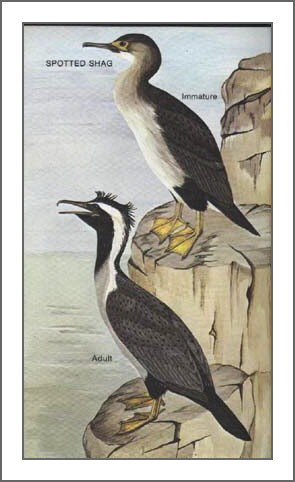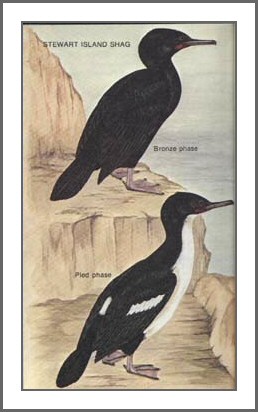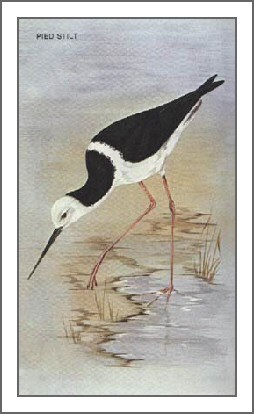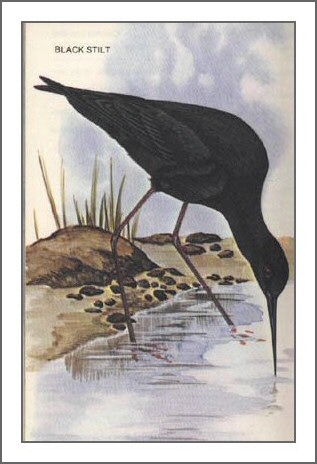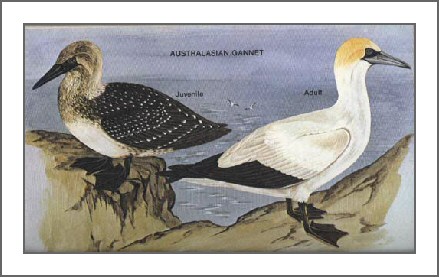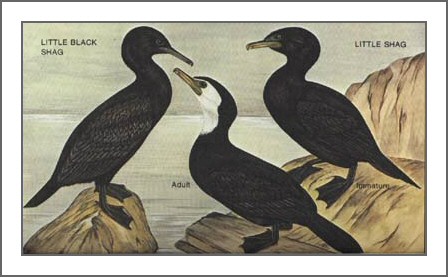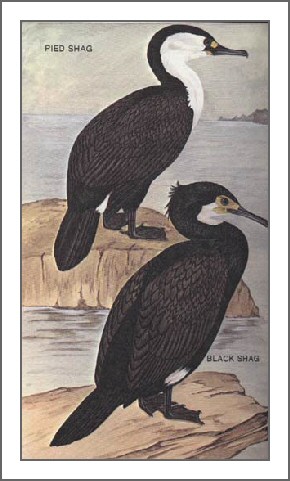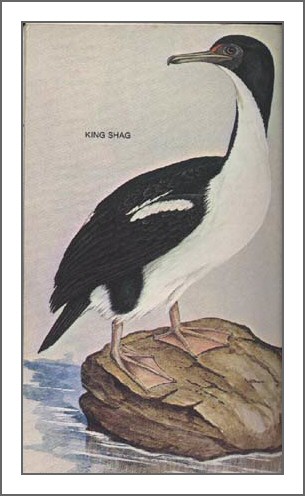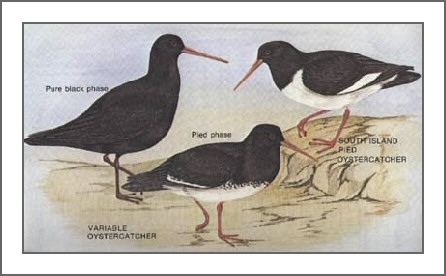

![]()
 (from
K is for KIWI, Reed)
(from
K is for KIWI, Reed)
There's a wall in my garden, where lots of orchids grow, watched over by a Little Owl when the sun is all aglow. And through a round hole in the wall I can view the sparkling sea and oystercatchers feeding busily in the estuary. Suddenly an owlet moth comes fluttering by, bemusing the owl as they stare eye to eye, while I pick up my trowel and planting tool, and plant another orchid in the wall.
|
SCROLL DOWN TO FIND THE FOLLOWING COASTAL BIRDS:
SPOTTED SHAG; AUSTRALASIAN GANNET; LITTLE BLACK SHAG & LITTLE SHAG; STEWART ISLAND SHAG; PIED & BLACK SHAG; KING SHAG; PIED STILT; BLACK STILT; OYSTERCATCHER.
|
|
|
SPOTTED SHAG / Parakareka
Spotted Shag Stictocarbo punctatus FAMILY: Phalacrocoracidae Endemic with two closely related sub-species in NZ. Fully protected. Common, but patchily distributed throughout the North and South Islands. Only found on the coast, they feed on small fish and crustacea. Breeding occurrs throughout the year. The nest of sticks, seaweed and cliff plants, is in colonies on ledges, fissures in steep cliffs or sea caves, usually with overhead cover. The eggs, 2-4, are pale blue with a chalky outer layer.
The BLUE SHAG, (Stictocarbo p. steadi) is generally found on Stewart Island, Foveaux Strait and the West Coast of the Sth Island. This bird has a darker plumage. STEWART ISLAND SHAG
Stewart Island Shag Leucocarbo carunculatus chalconotus FAMILY: Phalacrocoracidae Endemic to NZ with two closely related sub-species in NZ. Fully protected. This bird has two colour phases, 'Bronze' and 'Pied' in equal proportions.The conspicuous white wing and back patches distinguish the 'Pied Phase' from the Pied Shag. Found from Otago Peninsula to Foveaux Strait and Stewart Island. They only inhabit coastal waters and food consists of small fish. Breeding is from July to September. The nest is cup shaped, of grasses and seaweed, cemented with droppings and in tight colonies on cliffs and rocky islands. The eggs, 2-3, are pale green with a chalky outer layer. Both phases interbreed, producing either 'Pied' or 'Bronze' young.
PIED STILT / Poaka
Pied Stilt Himantopus himantopus FAMILY: Recurvirostridae Native to NZ. Found throughout the world in temperate and tropical regions. Striking black and white plumage with long pink legs, which trail far beyond the tail when the bird is in flight. Its call is a monotonous yapping. Young birds have a grey back of neck with some dark areas around the eyes. Pied Stilt are common throughout NZ anywhere where there is water, up to 3000ft. They can be seen on lake edges, wet paddocks, marshes and riverbeds, moving from inland areas to the coast in Autumn. They feed on worms, snails, aquatic insects and shellfish. Breeding is from September to January. The nests vary in size from scrapes in shingle lined with sparse grass to much larger nest made of grass and weeds. They are mostly in the open and sometimes in clumps of grass. The eggs, usually 4, are coloured buff to orange-brown heavily marked all over with black and brown spots and blotches.
BLACK STILT / Kaki
Black Stilt Himantopus novaezealandiae FAMILY: Recurvirostridae Endemic and fully protected. Total black plumage with bright red eyes. The female is browner and the immature has white below, black above with a grey neck and smudged white face. The spindly pink legs trail in flight. Black Stilt used to be widespread, but are now extremely rare. Breeding is confined to the Waitaki River system in South Canterbury. They are mainly sedentary through the year on shingle riverbeds and lakesides. Some black or almost black birds are seen in Winter as far north as Auckland with Pied Shags in wet, swampy habitat. Food consists of aquatic insect and crustacea. Breeding is from September to December and the nest is a depression in the sand and gravel, in the open and close to water. The eggs, 3-4, are light buff to olive-brown, heavily marked with black and brown spots and blotches.
VARIABLE OYSTERCATCHER Variable Oystercatcher Haematopus unicolor FAMILY: Haematopodidae. Endemic and fully protected. Larger than the Sth Island Pied Oystercatcher (SIPO) with 2 basic colour phases, 'Pure Black' and 'Pied'. The 'Pied' differs from the Sth Island Pied by having a smudgy seperation between the black and white and no white on the shoulder in front of the wing. They have a narrow white wing stripe and white only on the lower back. Many birds show intermediate plumages between both phases and pairs may consist of both phases. They are only found on beaches and coast, throughout NZ and many offshore islands. They feed on shellfish, worms and crustacea. Breeding is from October to January and the nest is a scrape in sand or shingle. The eggs, usaully 3, are greyish or greenish, closely marked with dark brown or black spots and blotches.
|
AUSTRALASIAN GANNET / Takapu Australasian Gannet Sula bassana FAMILY: Sulidae. Native to NZ, also in Southern Australia. There are two related sub-species in Sth Africa and the Nth Atlantic. The size of a goose, these birds are often in flocks, diving from high for food. Found mainly in the Nth Island in Summer, dispersing widely in Winter. Breeding occurs mainly on offshore islands round the northern half of the Nth Island, the mainland colonies being at Cape Kidnappers and Farewell Spit at the top of the South Island. Most young birds spend at least two years in Australian waters. They feed by diving for small fish. Breeding is from August to December and the nest is a cup-shaped mound of seaweed, iceplant, and grasses cemented with droppings, and in closely packed colonies. The egg, 1, is pale bluish or greenish-white with a chalky surface.
LITTLE BLACK SHAG & LITTLE SHAG / Kawaupaka
Little Black Shag Phalacrocorax sulciristris FAMILY: Phalacrocoracidae Native, also found in Australia and the Sth West Pacific. Fully protected. A little smaller than the Little Shag, this bird has a long, slender dark bill and short tail, with no crest on the head. There is a 'scalloped' appearance to the back and wing feathers. Only found in the Nth Island, they are more common in the northern half, on fresh water lakes, salt water lagoons and the coast. They often feed in groups, by diving on the waters surface for small fish and eels. They breed in only a few localities, from February to May, September to December. The nest is built of sticks and grasses and set in tree colonies, which are sometimes mixed with Little Shags, Black and Pied Shags. The eggs, 2-4, are pale blue with a chalky surface.
BLACK SHAG / Kawau & PIED SHAG / Kahuriruhi
Black Shag Phalacrocorax carbo FAMILY: Phalacrocoracidae. Native with similar sub-species in Australia, Europe, Africa, Asia and North America. Not protected. This is the largest shag in NZ, with the white thigh patches and green-black head plumes only seen in the breeding season. The immature bird is browner than the adult, and lighter on the undersides. Found throughout the country on rivers, lagoons, inland lakes and sea coast. They feed by diving from the waters surface for fish, eels and freshwater crayfish. Breeding is from April to May and September to October, with possibly 2 broods. The nest is a large structure of sticks, in colonies in high trees or rock ledges, and lower down, close to or surrounded by water. The eggs, 3-4, are pale bluish-green with a white chalky surface.
Pied Shag Phalacrocorax various FAMILY: Phalacrocoracidae. Native with similar sub-species in Australia and Tasmania. Fully protected. Slightly smaller than the Black Shag with black thighs and face, neck and underparts white. Immature birds are blackish-brown above and white, mottled with blackish-brown, below. They are found on the coast throughout the country, but are more numerous north of both main islands and Stewart Island. They rarely travel inland. Food consists mainly of marine fish, and sometimes they will feed in freshwater. Breeding is similar to the Black Shag, often in mixed colonies of Black and Little Shags. The eggs, 2-4, are pale blue, with a chalky white surface.
KING SHAG / Kawau King Shag Leucocarbo c. carunculatus FAMILY: Phalacrocoracidae. Endemic to NZ with two closely related sub-species in Southern NZ and the Chatham Islands. Fully protected. As big as the Black Shag this bird has conspicuous white markings on the upper wing, base of the wing and lower back. The immature bird has a brown upper surface with usually no white patches. This is one of the rarest shags in the world and is confined to a few small, rocky islets in Cook Strait, at the margins of the Marlborough Sounds. They are found only in coastal waters and feed on fish and crustaceans. Breeding is variable from May to November. The nest is built high on exposed sloping rocks. It is a built-up cup of seaweed and other vegetable matter, cemented with droppings, and in colonies. The eggs, 2-3, are pale green with a thin white chalky surface.
SOUTH ISLAND PIED OYSTERCATCHER / Torea
Sth Island Pied Oystercatcher Haematopus ostralegus FAMILY: Haematopodidae Native with similar sub-species in Australia, Sth America and the Northern Hemisphere. Black upper parts seperated sharply from the white below. In flight there is a prominent broad white wing stripe and white back from the rump to the shoulders. These birds are seen from January to August on coasts throughout NZ, in large flocks on estuaries, mudflats and paddocks. They feed on worms, larvae, crustacea and shellfish. Breeding occurs only inland on Sth Island riverbeds from September to November. The nest is a scrape in river sand and shingle. The eggs, 2-3, vary from pale brown to cream, with dark brown and black spots and blotches all over.
|
Copyright(c) 2006 Janet Marshall. All rights reserved.
myid@myhost.com
nbsp;
nbsp;

















